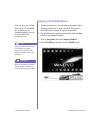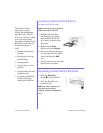
M
Y
P
RESARIO
—G
ETTING
S
TARTED
U
SING
Y
OUR
C
OMPUTER
2-13
Diskette, Hard Drive, CD-ROM, CD-RW, DVD-ROM, and Zip Drives
Using the Diskette Drive
1. Hold a diskette with the
label facing up and the
arrow on the diskette
pointing toward the drive;
then gently push the diskette
into the drive.
2. To remove a diskette, press
the Eject button 1
on the diskette drive.
▲
Caution: Wait until the
diskette-drive activity is
complete (the activity light
2 stops glowing) before
removing a diskette. Removing
a diskette when the drive is
reading from or writing to the
diskette can damage the
diskette or the information
stored on it.
Note: Remove the diskette from the drive
prior to shutting down Microsoft Windows.
Using the Hard Drive
The hard drive stores system files, software, and data files inside
your computer. When you install software, download files from
the Internet, receive e-mail and attachments, or create new files,
the computer saves them on your hard drive. The available
storage space is gradually used. To regain storage space, you can
delete files or programmes loaded on your computer, or save
them on external media such as diskettes, CD-R or CD-RW
discs.
Diskette, Hard
Drive, CD-ROM,
CD-RW,
DVD-ROM, and
Zip Drives
Your computer may have
one or more drives
depending on the model
you purchased:
➜
Diskette drive
➜
Hard drive
➜
CD-ROM drive
➜
CD-RW drive
➜
DVD-ROM drive
➜
Zip drive
Each drive has different
size capacities for storing
information.
The diskette drive uses a
diskette to store files. Once
information is copied onto
a diskette, it remains there
until you delete or
overwrite it.
The other drives are
discussed on the following
pages.


















